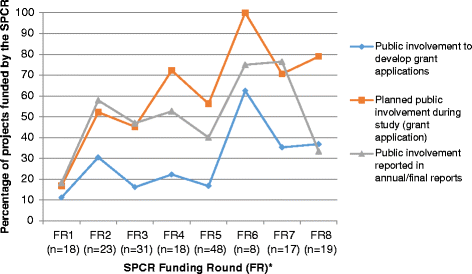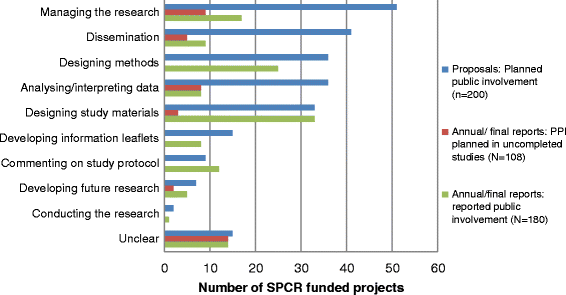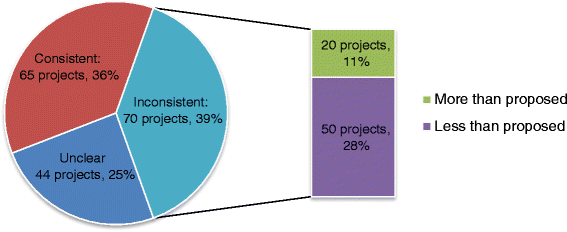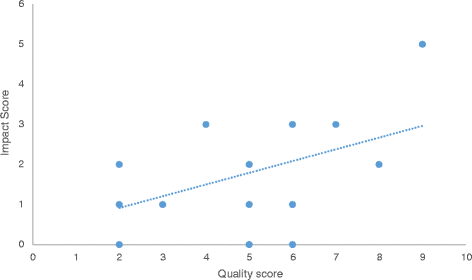The extent, quality and impact of patient and public involvement in primary care research: a mixed methods study
- PMID: 29850029
- PMCID: PMC5966874
- DOI: 10.1186/s40900-018-0100-8
The extent, quality and impact of patient and public involvement in primary care research: a mixed methods study
Abstract
Plain english summary: In the UK, more patients go to primary care than other parts of the health service. Therefore it is important for research into primary care to include the insights and views of people who receive these services. To explore the extent, quality and impact of patient and public involvement (PPI) in primary care research, we examined documents of 200 projects and surveyed 191 researchers.We found that about half of studies included PPI to develop research ideas and during the study itself. Common activities included designing study materials, advising on methods, and managing the research. Some studies did not undertake the PPI activities initially planned and funded for. PPI varied by study design, health condition and study population. We found pockets of good practice: having a PPI budget, supporting PPI contributors, and PPI informing recruitment issues. However, good practice was lacking in other areas. Few projects offered PPI contributors training, used PPI to develop information for participants about study progress and included PPI to advise on publishing findings.Researchers reported beneficial impacts of PPI. Most impact was reported when the approach to PPI included more indicators of good practice. The main cost of PPI for researchers was their time. Many reported difficulties providing information about PPI.In partnership with PPI contributors, we have used these findings to develop:a new Cost and Consequences Framework for PPI highlighting financial and non-financial costs, benefits and harms of PPIFifteen co-produced recommendations to improve the practice and delivery of PPI.
Abstract: Background: To improve the lives of patients in primary care requires the involvement of service users in primary care research. We aimed to explore the extent, quality and impact of patient and public involvement (PPI) in primary care research.Methods: We extracted information about PPI from grant applications, reports and an electronic survey of researchers of studies funded by the NIHR School for Primary Care Research (SPCR). We applied recognised quality indicators to assess the quality of PPI and assessed its impact on research.Results: We examined 200 grant applications and reports of 181 projects. PPI was evident in the development of 47 (24%) grant applications. 113 (57%) grant applications included plans for PPI during the study, mostly in study design, oversight, and dissemination. PPI during projects was reported for 83 (46%) projects, including designing study materials and managing the research. We identified inconsistencies between planned and reported PPI. PPI varied by study design, health condition and study population.Of 46 (24%) of 191 questionnaires completed, 15 reported PPI activity. Several projects showed best practice according to guidelines, in terms of having a PPI budget, supporting PPI contributors, and PPI informing recruitment issues. However few projects offered PPI contributors training, used PPI to develop information for participants about study progress, and had PPI in advising on dissemination.Beneficial impacts of PPI in designing studies and writing participant information was frequently reported. Less impact was reported on developing funding applications, managing or carrying out the research. The main cost of PPI for researchers was their time. Many researchers found it difficult to provide information about PPI activities.Our findings informed:a new Cost and Consequences Framework for PPI in primary care research highlighting financial and non-financial costs, plus the benefits and harms of PPIFifteen co-produced recommendations to improve PPI in research and within the SPCR.Conclusions: The extent, quality and impact of PPI in primary care research is inconsistent across research design and topics. Pockets of good practice were identified making a positive impact on research. The new Cost and Consequences Framework may help others assess the impact of PPI.
Keywords: Cost and consequences framework; Impact; Mixed methods, primary care research; Patient and public involvement; Quality.
Conflict of interest statement
Ethical approval was obtained from Keele University’s Research Ethics Committee (21st March 2014). Respondents to the survey were informed that a return of a completed questionnaire implied informed consent to participate in the study and share anonymous information publicly.The authors declare that they have no competing interests.Springer Nature remains neutral with regard to jurisdictional claims in published maps and institutional affiliations.
Figures





References
-
- National Institute for Health Research. NIHR annual report 2015/16: National Institute for Health Research; 2016. https://www.nihr.ac.uk/about-us/documents/NIHR-Annual-Report-2015-16.pdf. Accessed 1 Dec 2017
-
- INVOLVE. Briefing notes for researchers: involving the public in NHS, public health and social care research: INVOLVE; 2012. http://www.invo.org.uk/wp-content/uploads/2014/11/9938_INVOLVE_Briefing_.... Accessed 1 Dec 2017
-
- National Institute for Health Research. Going the extra mile - a strategic review of public involvement in the National Institute for Health Research: National Institute for Health Research; 2015. https://www.nihr.ac.uk/patients-and-public/documents/Going-the-Extra-Mil.... Accessed 4 May 2018
-
- INVOLVE. Public involvement in research: values and principles framework: INVOLVE; 2016. http://www.invo.org.uk/posttypepublication/public-involvement-in-researc.... Accessed 4 May 2018
-
- Mathie E, Wilson P, Poland F, McNeilly E, Howe A, Staniszewska S, et al. Consumer involvement in health research: a UK scoping and survey. Int J Consum Stud. 2014;38(1):35–44. doi: 10.1111/ijcs.12072. - DOI
LinkOut - more resources
Full Text Sources
Other Literature Sources

